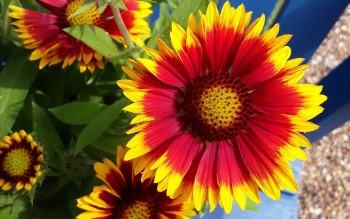There are over 70 varieties of sunflowers, and most are the annual varieties that we’re all familiar with, unfortunately, they last for one summer only, but this is not so with the Gaillardia.
With a little bit of easy care, the Gaillardia Sunflower comes back every year. Fantastic!
So, what is the Gaillardia sunflower? Gaillardia Sunflower or blanket flower is a perennial. It grows 1-3 feet tall (30cm-1m) and 18 in wide (40cm), with 2in(6cm) multi blooms in vibrant golden yellows, oranges, and reds. Ideal for mass coverage, borders, and containers. gaillardia is easily grown and native to north and south America.
The Gaillardia is a compact, brightly colored bushy sunflower that is usually found growing wild on the verge of roads in the north and southwest of America. It is loved by wildlife and constantly flowers throughout the summer and early autumn months.
Gaillardia may be a small, and lesser known sunflower, but nonetheless, it has its place amongst the biggest and tallest sunflowers that are already known and loved. So, let’s delve a little deeper into why gardeners and wildlife find this jeweled treasure so attractive.
Table of Contents
- Scientific Classification
- What a Gaillardia looks like
- Click and get the seeds, buy your seeds here, purchase your seeds here
- How and When to Grow Gaillardia from seeds
- Basic Gardening terms
- Where to place your Gaillardia
- How to care for your plant
- Harvesting the seeds, and storing them
- Quick and easy growing guide to save
- How and when to divide Gaillardia plants
- End of growing season care
Scientific Classification of the Gaillardia Sunflower
Kingdom: Plantae > Clade: Angiosperms > Clade: Eudicots > Clade Asterids > Order: Asterales > Family: Asteraceae > Genus: Gaillardia > Species: Helianthodae H.
Botanical Name
Gaillardia x Grandiflora
Common Name
Gaillardia or Blanket flower, and Fire Wheel.
My Pet Name For This Lovely Sunflower
Firecracker 🙂
What the Gaillardia Sunflower Looks Like
I’m not surprised this sunflower has become popular with gardeners all over the world. I’ve fallen in love with its versatility and the firework flowers that come popping out from early summer until autumn.
And with not much care it comes back year after year.
The Gaillardia grows 1 to 3 feet tall (30cm to 1m) and 18 in (40cm) wide, and can spread much further when in the ground, but can happily and easily be contained in a pot. The dense bushy plant is made up of long, thin linear green leaves.
Branching out from the center plant is a multitude of flower stems, they are long, thin and hairy. On top of each stem is a showy flower of vibrant red, orange and yellow petals surrounding a red, yellow or orange center disc.
The outer edge of each petal has three prongs, these prongs make them look like fire licks, hence one of its other names Fire Wheel.
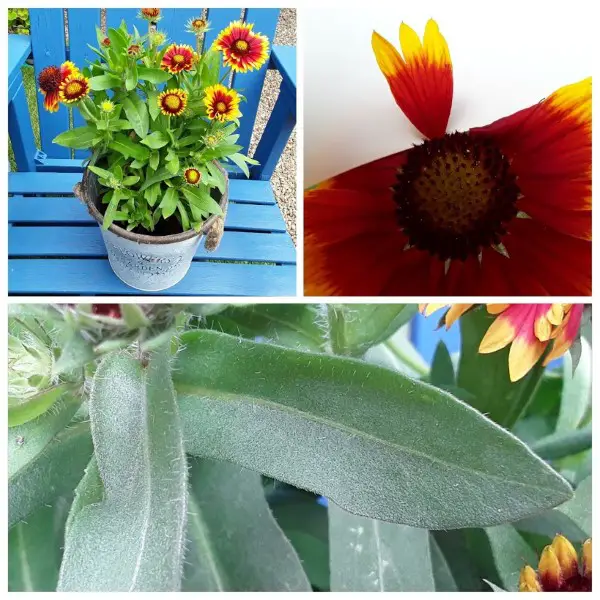
Where to Place Gaillardia and Its Uses
This gorgeous bushy sunflower is usually found growing wild by the roadsides in the north and southwest of America. The flowers start to come out at the beginning of spring and keep on blooming into the early autumn.
If you’re using the Gaillardia as a bedding plant, or in open grounds or raised beds, it would be best to place it in the middle or at the edge of your borders.
Because their flowers start blooming at the beginning of spring they are ideal for early butterflies and bees to feast on when there aren’t many other flowers yet to be found.
Being a big attraction throughout the summer to pollinators makes the Gaillardia ideal for companion planting with other flowers, herbs, and vegetables too.
You can also grow this sunflower in medium to large pots for your balcony, decking, patio, or conservatory.
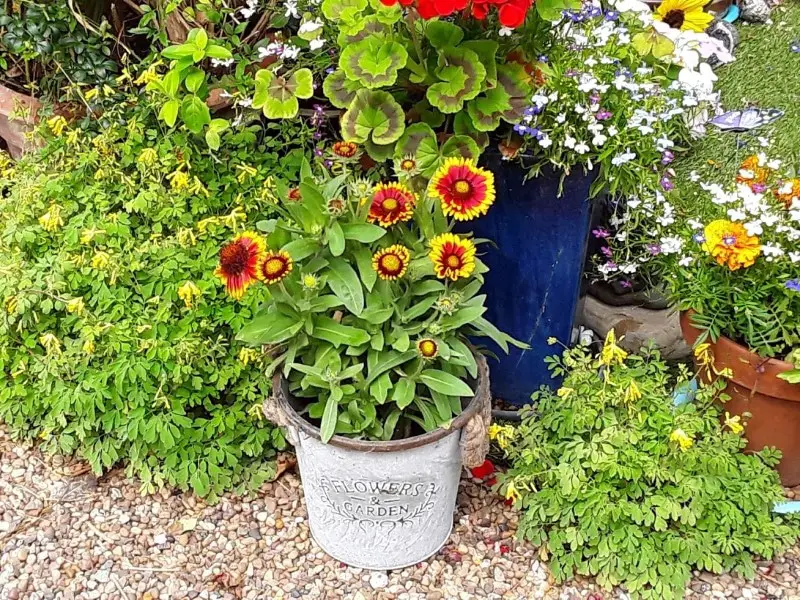
The flowers are vibrant and can be cut for display. I love having little vases and mason jars filled with these beauties, and they brighten up any surface I put them on.
How to Cut Gaillardia Sunflowers for Display
The best flowers to cut are the ones that are just starting to open from their buds. Follow the stem to the base of the plant then, with secateurs, or scissors, cut the stem to the length you need them.
Don’t worry you’re not stripping away all its flower growth. That’s the beauty of Gaillardia, it produces new flowers throughout the season. Deadheading and cutting flowers for display will encourage more buds to grow back.
Pick Your Own Gaillardia Seeds
If I’ve already enticed you into liking the idea of growing the Gaillardia Sunflowers, and you can’t find the seeds locally, or for your convenience, I’ve found them on amazon for you.
Gaillardia Sunflower Seeds
“Knowing we can get the seeds for sowing, let’s get growing.“
Gardening Terms
Let’s start with a few basic gardening terms and what they mean for the Gaillardia Sunflower.
- Perennial. Gaillardias are perennial which means they will come back every year.
- Annual means it will grow and live for one year only.
- Potting On. Divide seedlings or plants that have outgrown their pots, into their own pots, or bigger pots so they have more room to grow and mature.
- Thinning Out. If a number of seedlings are growing in the same growing site, and are too close together, remove the other plants and space them out accordingly, to give more room to grow.
- Planting Out. Planting seedlings or plants in their growing sites. Tender seedlings need to be hardened off before planting out.
- Dead Heading. The Gaillardia sunflower grows multiple heads throughout the season. Removing the deadheads encourages new buds and flowers to grow.
- Companion Planting. Sunflowers can be planted alongside other flowers, herbs, and vegetables. This helps to attract pollinators and good bugs to help prevent infestations and diseases. I’ve written an article about companion plants, and what not to plant next to sunflowers. I hope you find it helpful.
- Propagate by Division. Mature Gaillardia plants can be divided at their base. This creates another plant that can be placed elsewhere.
- Dripline. This is where water drops off the outermost leaves of a plant onto the ground like water dripping off an umbrella. This ‘drip line’ is where to dig up a plant for transplanting or to divide the plant to propagate a new plant.
- Cutting Back or Pruning. At the end of the growing season, usually during late summer and early autumn, a lot of perennial plants need to be cut back or pruned. This puts the plant in dormancy throughout the winter, so it can take in nutrients and get strong again for the next growing season.
How to Grow Gaillardia Sunflower Seeds
As with most sunflowers, Gaillardia Sunflowers are easy to grow. So whether you have bought a packet of seeds or been gifted some seeds from a friend, or have bought it as a plant, or want to divide an existing plant.
Here are the answers to your questions about how, when, and where to plant them. And the aftercare they need too.
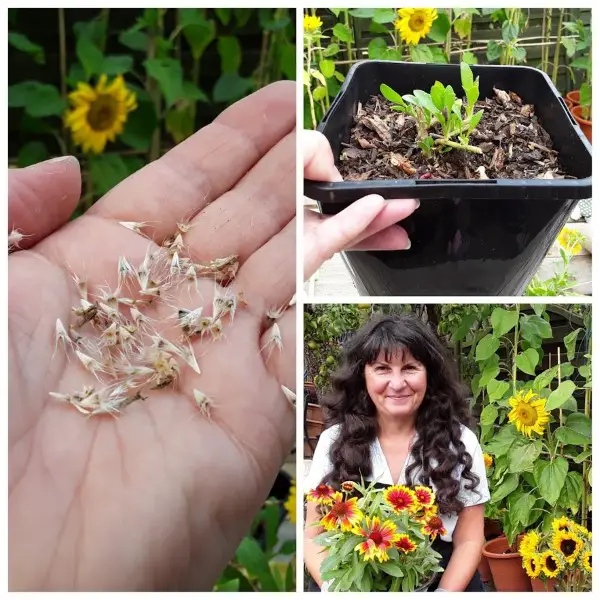
When to Sow Gaillardia Seeds
You can start seeds off indoors in pots from the middle of spring. Or outside when all fear of frost has gone. So, let’s start by growing them indoors. Here’s what to do…
How to Grow Gaillardia Seeds in Pots Indoors
- In the middle of spring, fill small clean pots with clean compost, or soil and plant 2 to 4 seeds per pot, and cover with ¼ inch (1cm) of fine soil.
- Water well and keep the soil damp, but not drenched. Place it in a sunny area like a window sill, or greenhouse if you have one.
- When the seedlings have their second set of leaves, ease the plants out of the compost and ‘pot on’ by gently separating each plant at its root. Replant them into individual pots, and put them back in their sunny place. Keep them moist with water.
- At the beginning of summer ‘plant on’ your Gaillardia Sunflowers in their growing site, or in a growing pot, put them in a place that has as much sun during the day as possible.
- the growing site or pots should be well prepared, with good drainage, and be weed free. If the soil you have is poor, dig in some slow-release plant food, or add a little liquid fertilizer when you water them.
- The distance between each plant should be about 15 inches (30cm) apart. This will give them room to grow and spread. This space also lets the air circulate around each plant, giving it a chance to fight off diseases and giving good bugs room to get in and protect them for you.
Top Tip; Keep your Sunflowers well-watered, try not to let them dry out, but don’t let them stand in a puddle. As the flowers appear and die off, deadhead them to encourage new buds and flowers to appear.
How to Sow and Grow Gaillardia Seeds Outside
Gaillardia Sunflowers need a sunny place to grow. Try and prepare your growing site at least a few weeks before you want to start planting seeds.
Sunflowers can put up with growing in bad quality soil, but if you feel it is still too poor, then dig in some slow-release fertilizer or use plant liquid feed once a week, or add a little to your watering daily. Do this throughout their growing season.
- When all fear of frost has passed, sow Gaillardia Sunflower seeds thinly over the area you want to grow them.
- Cover them over with ¼ inch (1cm) of fine soil, firm the soil down, and gently water them in. Protect them with netting or wire mesh to stop critters from digging them up and feasting on them.
- When your seedlings start to appear and have grown their second true leaves, leave the strongest in place and ‘thin out’ the rest to about 15 inches (30cm) apart.
- Water them in, and if you feel your local wildlife might want to munch on them, protect them with deterrents and netting.
Top Tip; If you have too many sunflower seedlings leftover from thinning out, pot them up and gift them to family, friends, and neighbors.
How to Care for Your Gaillardia
Watering Gaillardias
Most sunflowers can withstand a bit of drying out, but as a rule, I’d advise keeping them well watered, but don’t leave them in a puddle of water. Gently water at the base of the plant, so as not to dislodge the soil around the roots.
Gaillardia Pests and Problems
Keep your sunflowers weed-free. Weeds will grow fast and suck all the water and nutrients away from your plants.
If weeds are a big problem, use a mulch or weed mat to keep in moisture, while keeping weeds at bay.
Watch out for pests and problems. Gather any creatures up as soon as you see them, such as cutworms, snails, slugs, and caterpillars, and put them in another area.
Protect your sunflowers from squirrels and other critters if they become a problem, by using netting, or placing feeders in other areas to entice them away to tastier treats.
Cut any diseased looking leaves from Giallardias, or surrounding plants, and discard them so they won’t spread spores onto your healthy plants.
How to Deadhead Gaillardias
- Regular Deadheading of Gaillardias encourages new buds to flower throughout the summer.
- You’ll need secateurs or scissors, and garden gloves if you have sensitive hands.
- Identify the deadheads that need to be cut. Follow the stem to the base of the plant and snip it.
Top Tip; You can discard all healthy deadheads and plant debris into the compost.
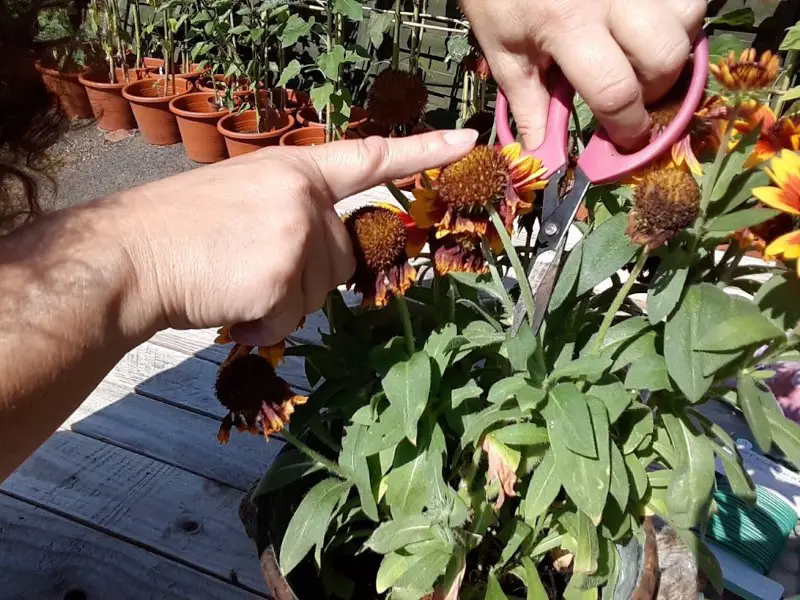
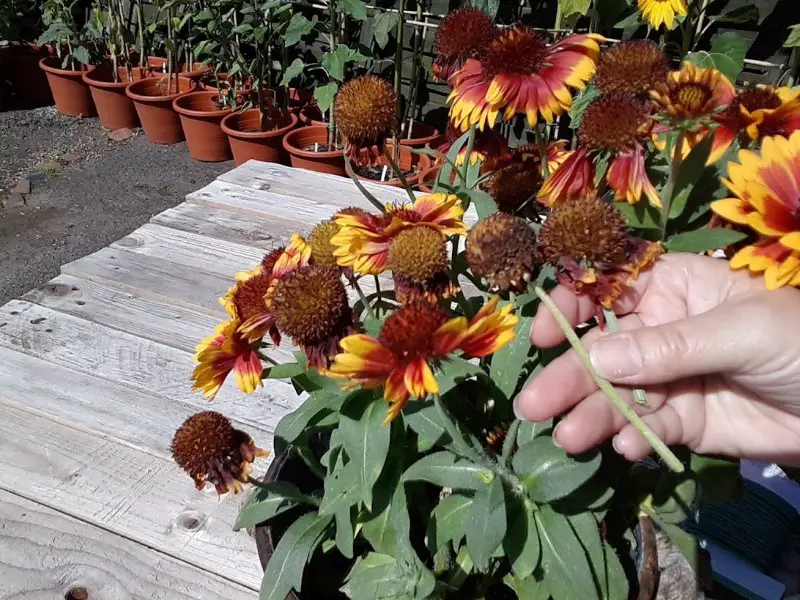
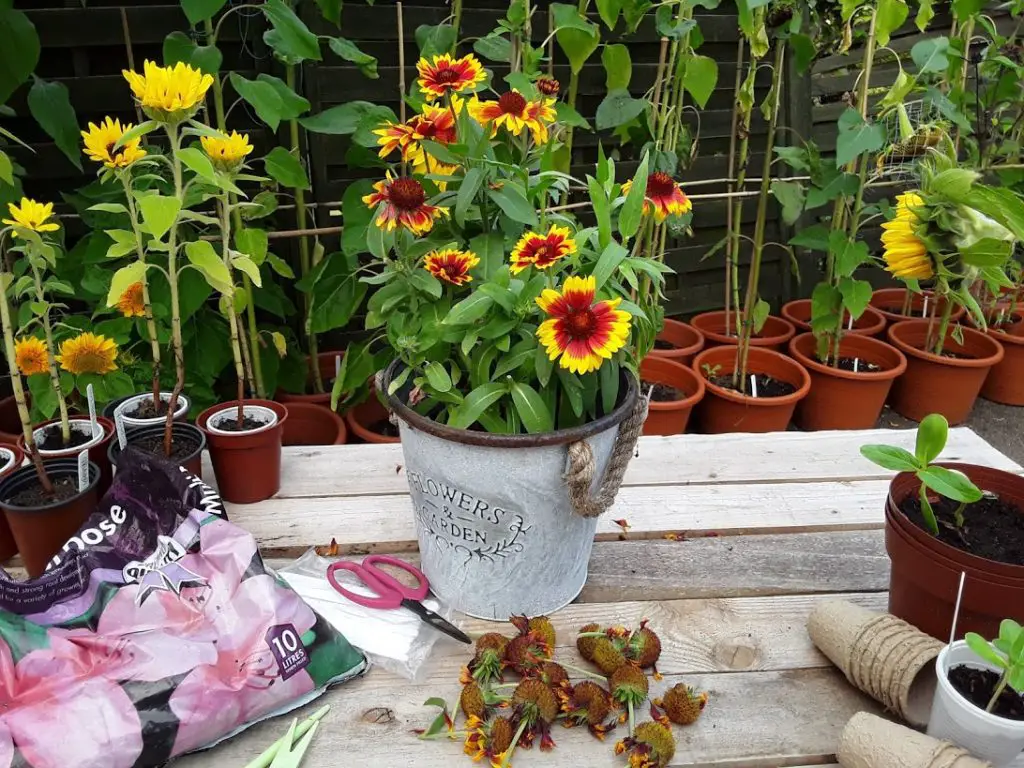
If you’re fascinated, like I was, as to why deadheading is good and important for your garden, and understand why and how nature encourages new growth, I’ve written an article all about it.
Why and how to deadhead plants and flowers
Harvesting Gaillardia Seeds
Gaillardias have small, but very vibrantly colored flowers that attract many pollinators. This means seeds should be plentiful too.
The seeds come after the bloom has died back. The seeds are only ⅛ inch (.5cm) long. They are light grey and triangular in shape, with little pointy wisps on them.
This is how to tell when the seeds of Gaillardias are ready to harvest.
- The flower head starts losing its vibrant color and turns a dusty color.
- Their petals dry up and start to fall from the dead bloom.
- Birds or other beasties start to munch on the dried flower heads. Because seeds are a feast to them.
Gaillardia sunflower seeds are easy to collect. Here’s how…
Harvesting Equipment Needed
- Gardening gloves, if you have sensitive skin.
- Sharp shears, secateurs, or garden scissors.
- A bowl or tub to place the flower heads and catch the seeds in.
How to Harvest Gaillardia Seeds
- The seeds are quite small, so be ready with your container to catch them in.
- Select the flower head you want to collect seeds from and cut the stalk.
- Gently rub the seed head between your fingers and thumb. This will loosen and free the seeds.
Top Tip; I usually collect the amount I need to plant the following year. I also collect enough to give as gifts for my family and friends. The rest I happily leave in a pile for the birds and wildlife to munch on at their leisure.
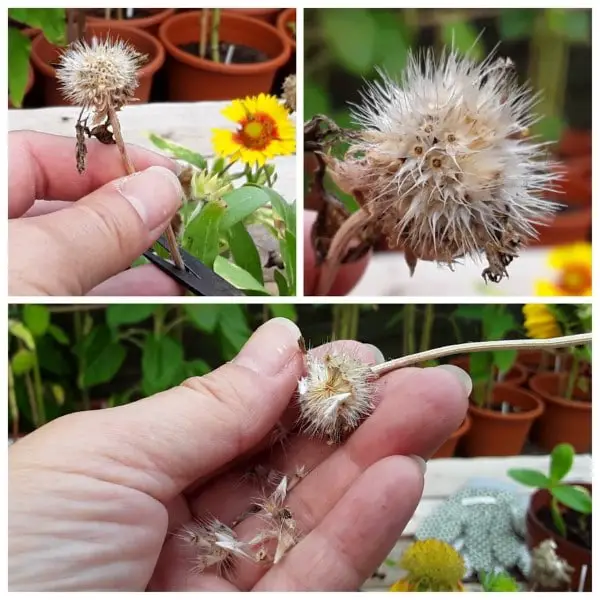
How to Store Gaillardia Seeds
Gaillardia seeds are usually dry when you pick them, but if they’re not, spread them out in a secure dry area (away from feathered friends) and allow them to air dry thoroughly.
Remove any plant debris from the seeds such as petals and stalks before storing them. Sunflower seeds can be stored in sealed paper bags, envelopes, sealed plastic bags, containers, or a sealed tin.
Store them in a cool, dark dry place. This will give them the best chance to grow next year. Store them away from the clutches of wildlife. And enjoy the fruits of your labor when you plant and grow them next year.
Top Tip: Remember to write the name and date on the container that you store your seeds in.
How to Propagate Gaillardia by Division
Propagating by division is a way of creating another plant by splitting a portion of the original mature plant away from itself. This gives the original plant more space to grow and the divided part can be replanted elsewhere in your garden, or in a pot.
Spring is the best time to divide your gaillardia sunflowers. And the ideal time of day to divide a plant is in the late afternoon, or early evening when it’s cooler.
- Choose the gaillardia you want to divide and soak it thoroughly with water the day before. This will prevent the plant from going into shock when you divide it.
- Choose a growing site that gets plenty of sun, and has good drainage.
- Prepare the new growing site. Dig over the ground and make a hole large enough to receive the root ball.
- At the ‘drip line’, Take your spade at a 45-degree angle towards the center of the plant and loosen the earth all the way around the outer edge of the part of the plant you want to divide.
- Once you’ve loosened the earth around the plant, go into the center of it, and start teasing free a division of your Gaillardia from its greater mass. Or you can slice away an area by cutting straight down with your spade. Take care to loosen up a good sized root ball. Replant your divided plant as soon as possible in its new growing site, or pots that you’ve already prepared.
- Fill in the soil around your new plant, firm it down, and water thoroughly.
- Make sure to fill back in the area you’ve dug up around the original plant. It’s wise not to leave any roots exposed and open to the elements.
Top Tip; if you have divided more plants than you need, gift them to family, friends, and neighbors, or donate them to plant sales.
Gaillardia Care at the End of the Growing Season
At the end of the growing season, usually during late summer and early autumn, you’ll notice that the Gillardia starts drying up and looking straggly. ‘Perennial’ plants need to be cut back or pruned. For the Gaillardia this means it needs to be cut back to just above ground level.
Cutting back this sunflower gives it the best possible chance to take in nutrients, and gain its strength back to grow healthy for its next growing season.
Cutting Back or Pruning Gaillardia Sunflowers
Gaillardias are easy to cut back. Here’s what to do…
- You’ll need secateurs or sturdy scissors and gardening gloves.
- Remove all spent garden annuals, weeds, and garden debris from around the plant.
- Then, go into the Gaillardia and remove any dried and loose plant matter that will come away easily.
- Find the center of the plant, where all the growth comes from.
- Tease the leaves and flower stalks up into your hand and hold them away from the plant center.
- Then, just above ground level snip the greenery at the center and base of the plant.
- Repeat steps 1 to 3 until you’ve finished cutting back the plants that require it.
Now that you’ve finished cutting back the plant it will go dormant over winter. In the spring you’ll see new shoots and growth coming from the base of the plant. This means your Gaillardia is waking up for another glorious season in the sun.
Top Tip; Any seed heads can be left out for the local birds and wildlife to enjoy. Discard all healthy plant debris into the compost, and any empty seed heads once they’ve been munched on.
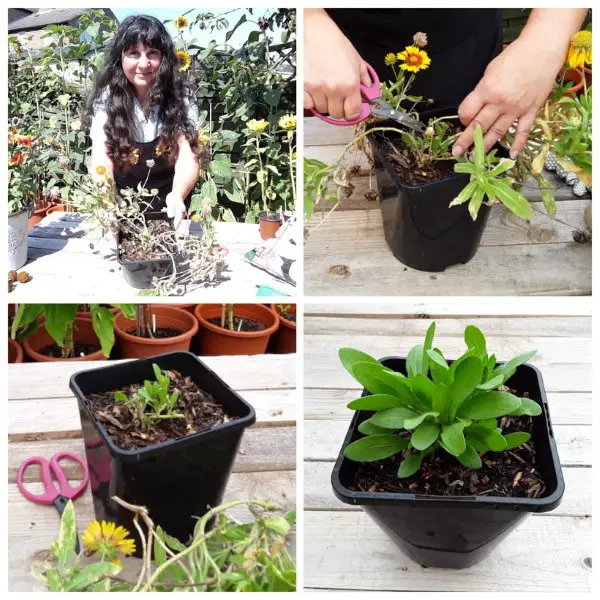
Gaillardia Sunflower Planting Guide and Chart
Depending on your climate and conditions the growth of your Gaillardia sunflowers may vary.
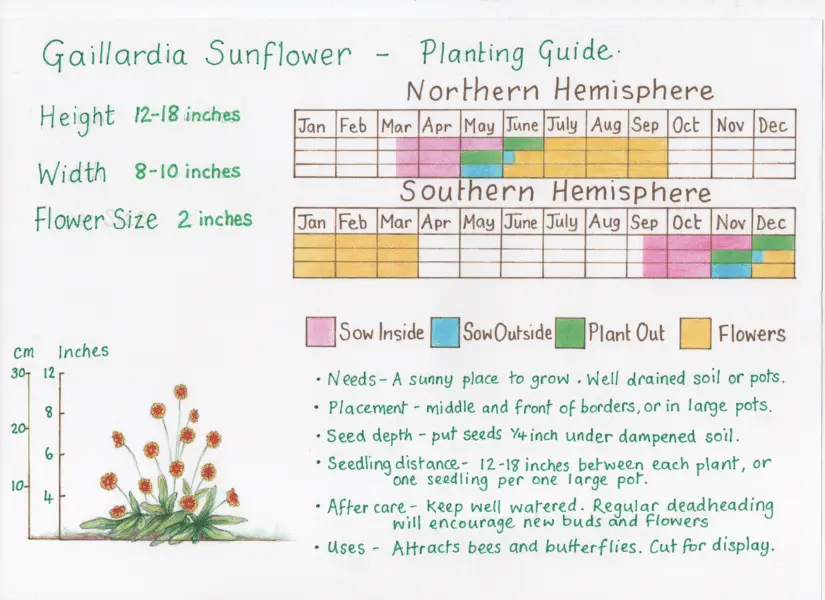
This is a summarized chart of how to sow, grow, and care for Gaillardia sunflowers. Please note, it is for your own personal use to print, pin or post. it is not for ….commercial gain or usage.
Pick Your Own Gaillardia Sunflower Seeds
If you can’t find the seeds locally, I’ve found them for you on Amazon just below.
Gaillardia Sunflower Seeds
My other helpful guides and articles
31 Most Wonderful Sunflowers to Grow
How to Grow Amazing Sunflowers
Do Sunflowers Need Lots of Water?
Why are My Sunflowers Drooping?
Best Sunflower Companion Plants
How to Harvest Sunflower Seeds
My Final Thoughts
When I first discovered the Gaillardia Sunflower I fell in love with its vibrant color and the mass of flowers it produces in one summer. Then, I was amazed at how versatile it became to me over the years. I plant it in my borders and beds, in pots and containers.
So, with this article, I hope I’ve helped you decide whether you’d like to grow them too. For your balcony, decking, or patio. Or use it as a companion plant for other flowers, vegetables, and herbs, or in a wildlife field…
Or, just one pot on your doorstep.
I hope you enjoy Gaillardia Sunflowers, as much as I do 🙂

